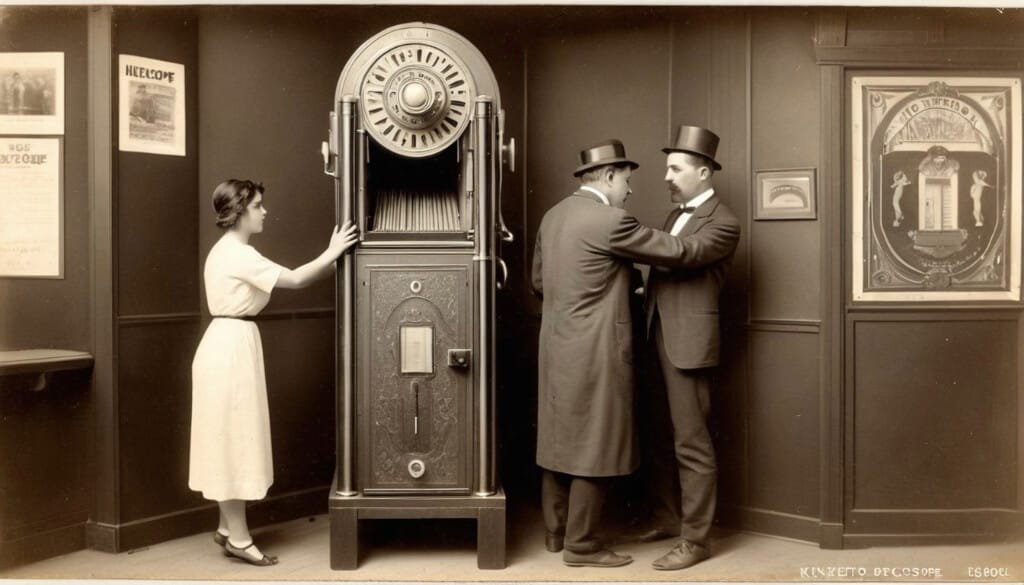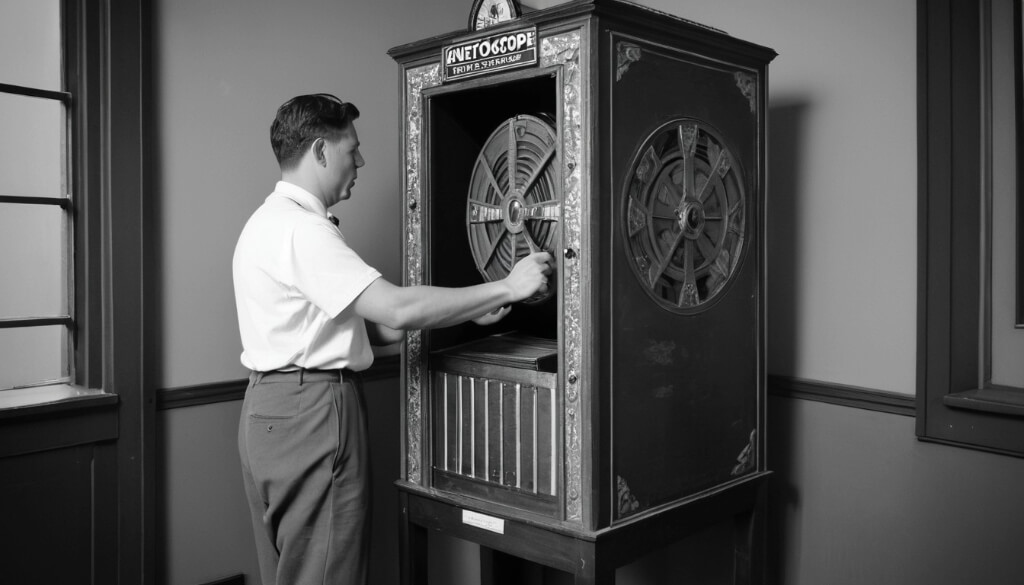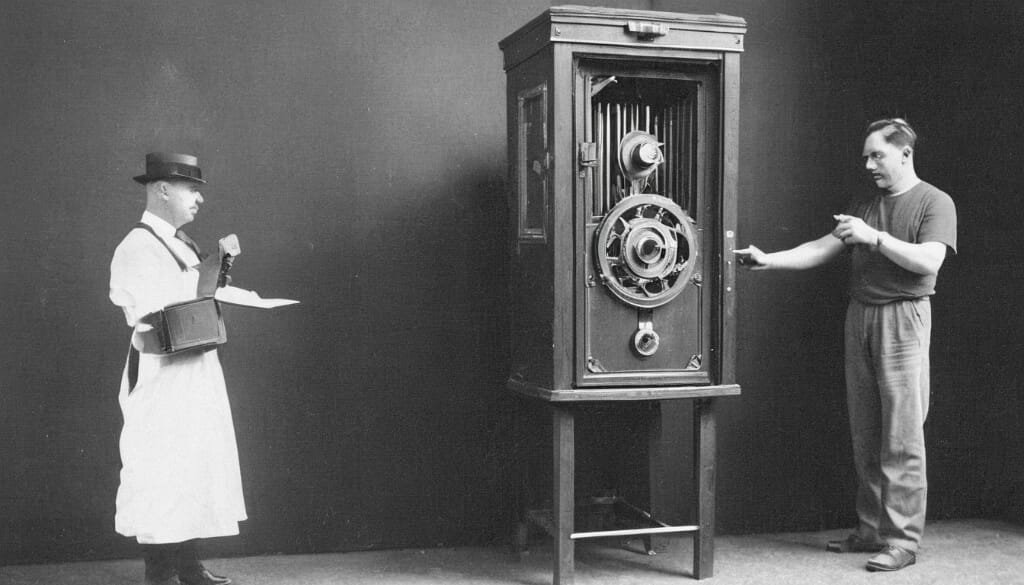In film history, few inventions hold as much significance as the kinetoscope. Developed in the late 19th century, this pioneering device marked the dawn of modern cinema, revolutionizing the way people experienced moving images. From its humble beginnings as a mechanical curiosity to its enduring legacy in contemporary culture, the kinetoscope remains a testament to human ingenuity and the power of innovation.

The Birth Of The Kinetoscope
The inception of the kinetoscope can be traced back to the late 19th century, a time of remarkable innovation and technological advancement. It was during this era that Thomas Edison, already renowned for his contributions to the fields of electricity and telecommunications, turned his attention to the realm of moving pictures.
In the early 1890s, Edison assembled a team of inventors and engineers to tackle the challenge of creating a device capable of capturing and displaying moving images. Among these collaborators were William Kennedy Laurie Dickson, an exceptionally talented inventor and photographer, and Charles Batchelor, a trusted colleague and confidant of Edison.
Together, this team embarked on a journey to bring Edison’s vision of a “peep-show machine” to life. Their efforts culminated in the development of the first iteration of the kinetoscope, which was patented by Edison in 1891. This early version of the device consisted of a viewing cabinet equipped with a small peephole, through which spectators could peer to watch short films.
The design of the kinetoscope was simple yet ingenious. Inside the viewing cabinet, a strip of celluloid film was passed over a series of rollers and illuminated by a bright light source. Each frame of the film was captured through a process of sequential photography, with the images depicting scenes of everyday life, comedy sketches, and staged performances.
One of the key innovations of the kinetoscope was its use of a sprocket-driven mechanism to advance the film strip, ensuring smooth and consistent motion. This mechanism, combined with the persistence of the vision phenomenon, created the illusion of continuous movement when the viewer looked through the peephole and turned a hand crank.
The unveiling of the kinetoscope marked a significant milestone in the history of visual entertainment. For the first time, audiences could experience the magic of moving images in a controlled environment, free from the distractions of the outside world. The popularity of the kinetoscope quickly spread, leading to the establishment of kinetoscope parlors in major cities around the world.
In the years that followed, Edison and his team continued to refine and improve upon the design of the kinetoscope, introducing innovations such as synchronized sound and color tinting. Despite facing competition from emerging technologies such as the cinematograph, which allowed for projected screenings to larger audiences, the kinetoscope remained a popular form of entertainment well into the early 20th century.
Today, the legacy of the kinetoscope lives on as a testament to human ingenuity and the power of innovation. Although the original devices may have long since been consigned to the annals of history, their impact on the evolution of cinema is undeniable. As we continue to push the boundaries of storytelling and visual expression, let us not forget the humble origins of the kinetoscope and the visionaries who dared to dream of a world filled with moving images.
How The Kinetoscope Works
At the heart of the kinetoscope’s mesmerizing display lies a deceptively simple yet ingeniously crafted mechanism. Understanding the inner workings of this pioneering device unveils the magic behind the illusion of moving pictures.
Central to the operation of the kinetoscope is its use of sequential photography and the persistence of vision phenomenon. This fundamental principle, rooted in human perception, allows discrete images presented in rapid succession to blend seamlessly, creating the illusion of continuous motion.
Within the confines of the kinetoscope’s viewing cabinet, a strip of celluloid film containing a series of individual frames is carefully threaded over a set of rollers. Each frame captures a single moment in time, frozen in photographic emulsion. These frames, when viewed in rapid succession, give rise to the illusion of movement.
As the viewer peers through the small peephole of the kinetoscope and turns a hand crank, the film strip is set into motion. A bright light source positioned behind the film illuminates the images, casting them onto a ground glass screen. The viewer, bathed in the soft glow of the projected light, is transported into a world of moving images and boundless imagination.
The key to achieving smooth and consistent motion lies in the precision of the kinetoscope’s sprocket-driven mechanism. A series of evenly spaced sprocket holes along the edges of the film strip engage with a set of gears, ensuring that each frame is advanced at a precise interval. This meticulous synchronization, combined with the persistence of vision phenomenon, creates the illusion of fluid motion with remarkable fidelity.
As the viewer cranks the handle of the kinetoscope, each frame of the film strip is rapidly displayed in succession. The images flicker to life before their eyes, imbued with a sense of vitality and realism. Whether depicting scenes of everyday life, staged performances, or fantastical adventures, the magic of the kinetoscope captivates and enthralls audiences of all ages.
The genius of the kinetoscope lies not only in its ability to capture and display moving images but also in its capacity to spark the imagination and evoke emotions. From the joyous laughter of a comedy sketch to the heart-pounding excitement of an action-packed drama, the kinetoscope transports viewers to worlds both familiar and fantastical.
In the annals of film history, the kinetoscope remains a testament to human ingenuity and the enduring power of innovation. Though its design may have evolved and its popularity waned in the face of new technologies, the legacy of the kinetoscope continues to inspire filmmakers and audiences alike. As we look back on the origins of cinema, let us not forget the humble beginnings of the kinetoscope and the boundless possibilities it unlocked for generations to come.
Impact On Entertainment And Culture
The introduction of the kinetoscope heralded a new era in entertainment, transforming the way people experienced visual media and leaving an indelible mark on popular culture. Its influence extended far beyond the confines of the viewing parlor, shaping the landscape of entertainment and society at large.
One of the most significant contributions of the kinetoscope was its role in democratizing access to moving images. Before its invention, the viewing of motion pictures was largely confined to public exhibitions and fairs, accessible only to those who could afford the price of admission. With the advent of the kinetoscope, however, the magic of moving pictures became available to a broader audience, as kinetoscope parlors sprang up in cities and towns across the globe. For the price of a few cents, patrons could step into these dimly lit establishments and immerse themselves in a world of cinematic wonder.

The popularity of the kinetoscope parlors transcended geographical and cultural boundaries, drawing audiences from all walks of life. From bustling metropolises to remote villages, these establishments became gathering places where people of diverse backgrounds could come together and share in the joy of cinematic discovery. Whether watching scenes of daily life unfold before their eyes or marveling at the latest technological innovations, patrons found common ground in their shared fascination with the magic of the kinetoscope.
Moreover, the kinetoscope played a pivotal role in shaping the nascent film industry, laying the groundwork for the development of narrative storytelling and cinematic techniques. Filmmakers experimented with new ways of capturing motion on film, pushing the boundaries of visual expression and expanding the possibilities of storytelling. From the Lumière brothers’ first public screening of moving pictures to Georges Méliès’ fantastical tales of adventure and imagination, the kinetoscope provided a platform for creativity and innovation, paving the way for the cinematic masterpieces that would follow.
Beyond its impact on entertainment, the kinetoscope also left an indelible mark on popular culture, influencing everything from fashion and music to literature and the visual arts. Images captured on kinetoscope films found their way into advertising, fashion plates, and newspaper illustrations, shaping the collective imagination of society at the turn of the century. The iconic imagery of the kinetoscope, with its flickering light and fleeting glimpses of life in motion, became emblematic of the modern age, symbolizing the boundless possibilities of technological progress and human ingenuity.
In the decades that followed, the legacy of the kinetoscope continued to reverberate throughout the world of entertainment and beyond. Its influence can be seen in the evolution of cinema, from the silent films of the early 20th century to the blockbusters of today. As we reflect on the impact of this pioneering device, let us not forget the role it played in shaping the cultural landscape of the modern world, inspiring generations of filmmakers and audiences alike to dream big and embrace the magic of the moving image.
Evolution And Legacy
The journey of the kinetoscope didn’t end with its initial introduction; instead, it sparked a series of innovations and advancements that would shape the future of cinema. As the 19th century gave way to the 20th, the kinetoscope evolved, adapting to changing technologies and cultural landscapes while leaving an enduring legacy in its wake.
One of the most significant developments in the evolution of the kinetoscope was the transition from individual viewing devices to projected screenings. While the original kinetoscope cabinets provided an intimate viewing experience for one viewer at a time, the desire to reach larger audiences led inventors to explore new methods of presentation. This culminated in the invention of the cinematograph, a device capable of projecting moving images onto a screen for collective viewing. Unlike the kinetoscope, which relied on peepholes and individual viewing cabinets, the cinematograph transformed the act of watching motion pictures into a communal experience, paving the way for the modern movie theater.
The advent of projected screenings marked a turning point in the history of cinema, democratizing access to moving images and expanding the possibilities of visual storytelling. Audiences flocked to theaters to experience the magic of projected motion pictures, captivated by the larger-than-life images that danced across the silver screen. Filmmakers embraced this new medium, experimenting with narrative techniques and visual effects to create immersive and unforgettable cinematic experiences.
Despite the rise of projected screenings, the legacy of the kinetoscope endured, influencing the development of cinematic technology and artistic expression. Filmmakers continued to draw inspiration from the early experiments in motion photography, incorporating elements of kinetoscope aesthetics into their work. From the use of close-ups and montage editing to the exploration of themes of movement and time, the legacy of the kinetoscope can be seen in the language of cinema itself.
Moreover, the impact of the kinetoscope extended beyond the realm of film, shaping the fields of photography, visual art, and popular culture. Its influence can be seen in the work of artists such as Marcel Duchamp and Salvador Dalí, who drew inspiration from the kinetic energy and sense of movement captured in kinetoscope films. The legacy of the kinetoscope also lives on in contemporary media, with filmmakers and artists continuing to explore the possibilities of motion and animation in the digital age.
As we reflect on the evolution and legacy of the kinetoscope, we are reminded of the enduring power of human creativity and innovation. Though the technology may have evolved, the spirit of experimentation and exploration that drove its invention remains as vibrant as ever. As we look to the future of cinema and visual storytelling, let us not forget the humble origins of the kinetoscope and the pioneering spirit that continues to inspire us to push the boundaries of what is possible.

Rediscovering The Kinetoscope Experience
In recent years, there has been a renewed interest in the kinetoscope experience, with enthusiasts and historians alike seeking to preserve and recreate this early form of entertainment. Authentic kinetoscope replicas have been constructed, allowing contemporary audiences to step back in time and witness the magic of early cinema for themselves. These efforts serve as a reminder of the enduring appeal of the kinetoscope and its place in the pantheon of film history.
Case Studies And Notable Films
The early days of the kinetoscope were marked by a flurry of creative experimentation and technological innovation, as filmmakers pushed the boundaries of what was possible with this groundbreaking medium. From the Lumière brothers’ first public screening of moving pictures to Georges Méliès’ fantastical tales of adventure and imagination, the kinetoscope provided a platform for filmmakers to showcase their creativity and innovation.
One of the most iconic kinetoscope films is “Workers Leaving the Lumière Factory” (1895), directed by Louis Lumière. This short film, often hailed as one of the earliest examples of cinematic realism, depicts workers leaving the Lumière factory in Lyon, France. Shot in a single continuous take, the film captures the hustle and bustle of everyday life with remarkable clarity and detail, offering audiences a glimpse into the world of industrialization and urbanization at the turn of the century.
Another notable kinetoscope film is “A Trip to the Moon” (1902), directed by Georges Méliès. This groundbreaking silent film, inspired by Jules Verne’s novel of the same name, tells the story of a group of astronomers who embark on a journey to the moon. Filled with elaborate sets, whimsical special effects, and imaginative storytelling, “A Trip to the Moon” is a testament to Méliès’ creative vision and technical prowess. It remains one of the most beloved and influential films of the silent era, inspiring generations of filmmakers and audiences with its sense of wonder and adventure.
In addition to these pioneering works, the kinetoscope also played host to a variety of other genres and styles, ranging from slapstick comedy to melodrama to documentary. Films such as “The Great Train Robbery” (1903), directed by Edwin S. Porter, and “The Kiss” (1896), directed by William Heise, captivated audiences with their thrilling action sequences and romantic encounters, respectively.
As the popularity of the kinetoscope grew, so too did the diversity of its offerings. Filmmakers experimented with new techniques and technologies, pushing the boundaries of visual storytelling and expanding the possibilities of the medium. Whether capturing scenes of everyday life or transporting audiences to far-off worlds, the kinetoscope films of the early 20th century continue to inspire and entertain viewers to this day.
In film history, the kinetoscope remains a testament to the power of human creativity and the enduring appeal of the moving image. As we look back on these early cinematic masterpieces, let us not forget the visionaries who dared to dream of a world filled with wonder and imagination. Their legacy lives on in the films they created, reminding us of the transformative power of storytelling and the magic of the silver screen.
Challenges And Criticisms
While the kinetoscope represented a major leap forward in the evolution of cinema, it was not without its limitations and criticisms. Some detractors viewed the medium as a mere novelty, lacking the artistic depth and narrative complexity of traditional forms of storytelling. Others raised concerns about the potential for exploitation and voyeurism in the burgeoning world of motion pictures. Despite these challenges, the kinetoscope persevered, paving the way for the cinematic masterpieces that would follow.
Final Thoughts
The kinetoscope stands as a testament to human innovation and the power of imagination. From its humble beginnings as a mechanical curiosity to its enduring legacy in contemporary culture, this pioneering device has left an indelible mark on the history of cinema. As we continue to explore the boundaries of storytelling and visual expression, let us not forget the humble origins of the kinetoscope and the visionaries who dared to dream of a world filled with moving images.
FAQs
What Is A Kinetoscope?
A kinetoscope is a device used for viewing moving pictures. It typically consists of a viewing cabinet with a peephole through which spectators can watch short, silent films.
Who Invented The Kinetoscope?
The kinetoscope was invented by Thomas Edison and his team of inventors in the late 19th century.
What Is The Significance Of The Kinetoscope In Film History?
The kinetoscope is significant because it marked the dawn of modern cinema, revolutionizing the way people experienced moving images and laying the groundwork for future advancements in film technology.
Also Read: Rediscovering Forgotten Pen Inventions Lost To Time
